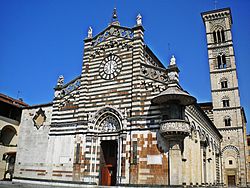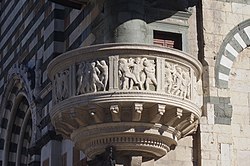
Back Prato (Toscana) AN براتو Arabic براتو ARZ Prato Azerbaijani پراتو AZB Prato BCL Прата Byelorussian Прата BE-X-OLD Прато Bulgarian Prato (Italia) Breton
Prato | |
|---|---|
| Comune di Prato | |
 | |
| Coordinates: 43°52′48″N 11°05′54″E / 43.88000°N 11.09833°E | |
| Country | Italy |
| Region | |
| Province | Prato (PO) |
| Frazioni | See list |
| Government | |
| • Mayor | Ilaria Bugetti (PD) |
| Area | |
• Total | 97.35 km2 (37.59 sq mi) |
| Elevation | 65 m (213 ft) |
| Population (1 January 2024)[2] | |
• Total | 198,034 |
| • Density | 2,000/km2 (5,300/sq mi) |
| Demonym | Pratese |
| Time zone | UTC+1 (CET) |
| • Summer (DST) | UTC+2 (CEST) |
| Postal code | 59100 |
| Dialing code | 0574 |
| ISTAT code | 100005 |
| Patron saint | St. Stephen |
| Saint day | 26 December |
| Website | Official website |





Prato (/ˈprɑːtoʊ/ PRAH-toh; Italian: [ˈpraːto] ) is a city and comune (municipality) in Tuscany, Italy, and is the capital of the province of Prato. The city lies in the northeast of Tuscany, at an elevation of 65 metres (213 ft), at the foot of Monte Retaia (the last peak in the Calvana chain). With 198,034 inhabitants as of 1 January 2024[update],[2] Prato is Tuscany's second largest city (after Florence) and the third largest in Central Italy (after Rome and Florence).
Historically, Prato's economy has been based on the textile industry and its district is the largest in Europe. The textile district of Prato is made up of about 7000 fashion companies, amounting to around 2 billion euros of city's export.[3] The renowned Datini archives are a significant collection of late medieval documents concerning economic and trade history, produced between 1363 and 1410.[4]
The city boasts important historical and artistic attractions, with a cultural span that started with the Etruscans and then expanded in the Middle Ages and reached its peak with the Renaissance, when artists such as Donatello, Filippo Lippi and Botticelli left their testimonies in the city. The famous cantucci, a type of biscotti invented in Prato during the Middle Ages, are still produced by local traditional bakers.
- ^ "Superficie di Comuni Province e Regioni italiane al 9 ottobre 2011". Italian National Institute of Statistics. Retrieved 16 March 2019.
- ^ a b "Popolazione residente al 1° gennaio : Tutti i comuni". Istat. Retrieved 13 February 2023.
- ^ "Distretto Tessile". Città di Prato (in Italian).
- ^ "THE DATINI's ARCHIVE". Fondazione Istituto Internazionale di Storia Economica F. Datini. Retrieved 13 February 2023.




